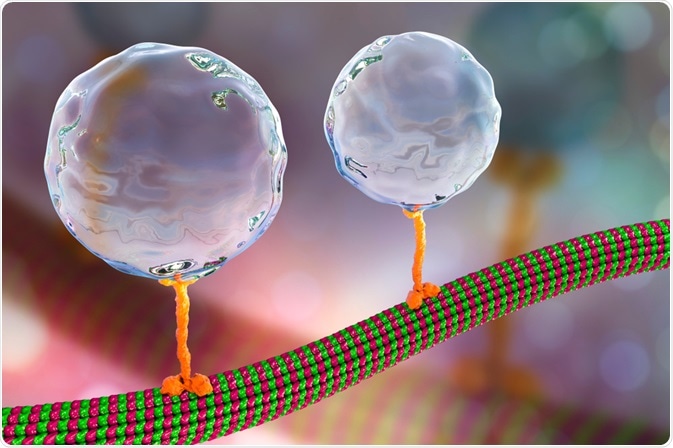Machines that cannot be seen
Certain biological molecules are able to move in a “quasi-mechanical” way, and these can be considered to be molecular machines. These are seen in many natural processes, and from this, biological-synthetic hybrid and fully synthetic molecular machines have been created. This began in the late 1960’s when a molecular machine called “roxatane” was synthesized.
 Image Credit: Kateryna Kon / Shutterstock.com
Image Credit: Kateryna Kon / Shutterstock.com
Biological molecular machines
One class of biological molecular machines is biological motors; this is a biological molecule capable of converting chemical energy into motion and can be important to biological functions such as muscle contraction, moving flagella of bacteria, and ATP hydrolysis. These motors can produce either linear (muscle contraction, flagella movement) or rotary (ATP hydrolysis) motions.
Examples of biological molecular machines include myosin, kinesin, dynein, and ribosomes.
- Myosin is a protein found in muscles, which is responsible for causing muscles to contract.
- Kinesin is a protein that moves “cargo” within the cell.
- Dynein is a protein that is part of the flagella of motile cilia and is responsible for the movement found in these proteins.
- Ribosomes are an essential part of protein synthesis, where the mRNA is translated into the corresponding polypeptide chain. During this process, the mRNA is read by the small subunit, and the large subunit joins the corresponding amino acids to form the polypeptide chain.
One advantage of biological molecular machines is that they are capable of performing complex functions. However, being biological, they are not extremely stable. Through understanding how biological molecular machines work, it is hoped that others can be created, which may detect and target cancer cells, or travel within the human body and detect potential health problems.
Biological-synthetic hybrid molecular machines
These biological molecular machines have been used as the basis for hybrid molecular machines, which combine features of said biological molecular machines and synthetic elements.
In one study, a nanovalve which is actuated by light was created, consisting of a channel protein and spiropyran, which is the photochemically active component. This hybrid molecular machine was used to control the movement of solutes across a lipid bilayer. UV light changes the hydrophobicity of the channel protein, which then opens the channel. Visible light reverses this process so that the channel becomes closed.
Synthetic molecular machines
Fully synthetic molecular machines have been designed as well, with the additional advantage of increased stability. These synthetic molecular machines can be broadly divided into seven different types.
- Molecular motors; these rotate in one direction with an energy input. The energy can be light or chemical.
- Molecular propellers; these also rotate, but move fluid around like a propeller. These are generally made of seven blades arranged around a shaft.
- Molecular switches; these are molecules that can exist in two equally stable forms, varied by conditions such as pH, light, temperature, and electric current.
- Molecular shuttles; rotaxane belongs to this class and is constructed using a macrocycle, through which a dumbbell-like molecule is threaded. This molecular machine can shuttle ions from one location to another by the movement of the dumbbell-like molecule along the macrocycle.
- Molecular tweezers; these are molecules that can contain an object in a cavity between its two arms. This is achieved through hydrogen bonds, metal coordination, hydrophobic forces, van der Waals and electrostatic forces.
- Molecular sensors; these molecular machines sense a particular analyte and then create a signal which can be measured. This can be used for detecting metal ions and changes in pH, for example.
- “Molecular logic gate”; these molecular machines need an input signal, usually chemical, and subsequently produce an output signal. For example, a chromophore that can respond to calcium ions shows an absorbance at 390nm, which is in the UV/visible range. Addition of calcium causes a shift in absorbance towards blue, which reduced the absorbance. Hydrogen, on the other hand, causes a shift towards red, which would then re-shift the absorbance up towards 390nm.
How are these molecular machines moved?
Biological molecular machines are usually moved by converting chemical, thermal, or light energy into kinetic energy. This is frequently the hydrolysis of ATP.
When it comes to synthetic molecular machines, some considerations must be taken into account; for example, to create a rotary motor, it needs to have 360˚ motion, to be able to control the direction and have an energy supply. The challenging is controlling the movement and direction in which the molecular machine moves in. Usually, the asymmetrical design gives better control, and a larger size is not necessarily associated with better performance. These rotors can be moved by Brownian motion, or in a unidirectional or a non-directional way.
These synthetic machines can be powered in various ways, including decomposition of H2O2 and the use of an inert metal to create an O2 gradient.
Sources
Richards, V (2016) chemistryworld.com Molecular Machines www.chemistryworld.com/features/molecular-machines/9457.article
Hindi, S. S. Z (2017) Molecular Machines: I. An Overview of Biological and Synthetic Angstromic Devices. Nanoscience and Nanotechnology Research http://pubs.sciepub.com/nnr/4/3/3/index.html
Further Reading
Last Updated: Jan 8, 2020